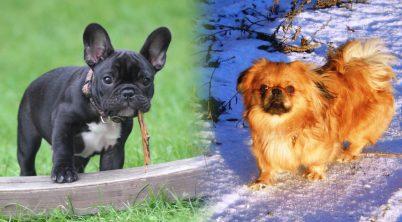Pekingese dogs are known for their distinctive appearance, with flat faces and a stocky build. However, this breed often faces respiratory challenges due to their brachycephalic (short-nosed) structure. Owners may notice their Pekingese coughing or gagging, which can be symptomatic of underlying health issues related to their unique anatomy. These breathing difficulties, while sometimes seen as benign, can indicate the presence of Brachycephalic Airway Syndrome (BAS), a condition commonly affecting short-nosed breeds.

Coughing and gagging in Pekingese can result from a variety of factors, including overexertion, overheating, or more serious health conditions. It’s important for owners to recognize the potential severity behind these symptoms. When a Pekingese exhibits such signs, it may struggle with narrowed airways, elongated soft palates, or other anatomical abnormalities that impede breathing. These issues can lead to decreased tolerance for exercise, distress after minimal activity, or serious respiratory crises.
Proactive management of a Pekingese’s health is crucial to prevent complications from coughing and gagging. Observing the dog’s breathing under different conditions, maintaining a healthy weight, and ensuring a cool environment can mitigate distressing symptoms. In some cases, veterinary intervention through medications or surgery may be required to alleviate severe obstructions in the airway. Careful monitoring and prompt veterinary care are key to ensuring the well-being of a Pekingese with such breathing difficulties.
Table of Contents
Understanding Canine Cough and Gagging
Coughing and gagging in dogs can be symptoms of various underlying conditions, ranging from mild irritations to serious illnesses. In Pekingese, these symptoms require careful attention due to their unique respiratory structures.
Causes of Cough and Gag
Congenital Conditions: Brachycephalic breeds like Pekingese have structural peculiarities in their airways, which can lead to chronic coughing and gagging.
- Tracheal Collapse: A weakened trachea can cause a harsh, dry cough often described as sounding like a goose honk.
- Laryngeal Dysfunction: Manifests as difficulty breathing and can be accompanied by gagging, especially when the dog is excited or exercising.
Infections:
- Kennel Cough: Highly contagious and characterized by a strong, persistent cough that often ends with a gagging sound.
- Pneumonia: Can lead to coughing and gagging due to mucus in the lungs.
Allergies and Irritants: Exposure to smoke, dust, or pollen can cause transient coughing and gagging due to irritation of the throat and airways.
Heart Disease: Conditions like congestive heart failure can lead to coughing due to fluid buildup in the lungs.
Parasites:
- Heartworms: These can cause coughing as they infest the heart and surrounding vessels.
Recognizing Different Types of Coughs
Understanding the sound and presentation of a Pekingese’s cough can provide clues to the underlying cause:
Dry and Hacking:
- Often associated with kennel cough or tracheal issues
- Sometimes followed by a gag, especially with tracheal collapse
Wet and Productive:
- May indicate lung disease such as pneumonia
- Gagging may occur as they try to clear mucus from the throat
Soft and Persistent:
- Can be due to heart disease or chronic bronchitis
- Heart disease-related coughs often worsen with exercise or at night
Pekingese-Specific Health Concerns

The Pekingese breed is predisposed to certain respiratory health issues due to their brachycephalic nature, which includes anatomical features such as a shortened snout and a compact skull structure. These can lead to serious breathing challenges.
Brachycephalic Airway Syndrome
Brachycephalic Airway Syndrome (BAS) is a primary concern in Pekingese, resulting from their distinctive head and facial structure. Key components of this syndrome include:
- Stenotic Nares: Narrowed nostrils that restrict airflow.
- Elongated Soft Palate: Excessive tissue length blocking the airway.
- Hypoplastic Trachea: An underdeveloped windpipe leading to reduced air movement.
- Laryngeal Collapse: Progressive weakening and collapse of the laryngeal structure.
- Everted Laryngeal Saccules: Turning out of the laryngeal tissue, further obstructing airflow.
Symptoms commonly observed in Pekingese with this syndrome are snoring, difficulty breathing, wheezing, and coughing.
Common Respiratory Issues in Pekingese
Apart from BAS, Pekingese may suffer from several respiratory conditions:
- Tracheal Collapse: A condition where the trachea rings flatten, causing a honking cough and breathing difficulties.
- Snoring and Wheezing: Due to their brachycephalic conformation, snoring and wheezing are common, often exacerbated by exercise or stress.
Owners should be attentive to their Pekingese’s breathing patterns and seek veterinary care if they observe persistent respiratory difficulties.
Diagnosis and Evaluation
When a Pekingese presents symptoms such as coughing and gagging, a thorough diagnosis and evaluation process, carried out by a veterinarian, is crucial.
The Role of Physical Examinations
A veterinarian would invariably begin with a physical exam. They closely inspect the dog’s breathing sounds, check for any nasal obstructions, and observe for signs of exercise intolerance. During the physical examination, the vet looks out for specific symptoms like respiratory difficulties and any abnormal noises that could indicate a compromised airway.
Advanced Diagnostic Tests
If the physical examination suggests a deeper problem, the veterinarian may recommend advanced diagnostic tests. Depending on the Pekingese’s symptoms, this could include:
- Radiographs (X-rays): X-rays can diagnose many conditions, such as collapsed trachea or heart enlargement, that might cause a dog to cough and gag.
- Endoscopy: This procedure involves inserting a fiber-optic tube into the dog’s airways to visualize the internal structures and identify obstructions or structural abnormalities.
Early and accurate diagnosis is pivotal in managing any underlying conditions that could lead to coughing and gagging in Pekingese dogs.
Treatment Options and Management

Effective management of Pekingese coughing and gagging focuses on medical interventions, potential surgical procedures, and adjustments to lifestyle and home care to alleviate symptoms and improve quality of life.
Medical Interventions
In cases where Pekingese dogs present with coughing and gagging due to inflammatory conditions, steroids may be prescribed to reduce inflammation and ease breathing difficulties. Cough suppressants could also play a role in providing relief. For severe respiratory distress, oxygen therapy is a critical intervention that can stabilize the dog’s condition. In instances of bacterial infections, antibiotics are necessary to treat the underlying cause.
- Steroids: Decrease inflammation in the airways.
- Cough Suppressants: Help minimize coughing episodes.
- Oxygen Therapy: Ensures adequate oxygenation for dogs in respiratory distress.
- Antibiotics: Combat bacterial infections that may cause coughing.
Surgical Procedures
Surgical treatment is considered for those with structural abnormalities contributing to their breathing problems. Procedures can range from correcting stenotic nares to more involved surgery on the soft palate or trachea. Surgery should always be deliberated carefully due to the increased anesthetic risk in brachycephalic breeds like Pekingese.
- Stenotic Nares Correction: Surgical widening of nostrils to facilitate easier breathing.
- Soft Palate Resection: Shortening of an elongated soft palate to prevent airway obstruction.
Lifestyle and Home Care
Managing a Pekingese’s environment and daily routine is crucial. Controlling obesity through diet and moderate exercise helps prevent exacerbation of breathing issues. However, they should avoid strenuous activities, particularly in hot weather, as they are more prone to heat stroke. Use of a harness rather than a collar can reduce pressure on the throat and aid in breathing.
- Weight Management: Avoid obesity, as excess weight can worsen respiratory difficulties.
- Moderate Exercise: Prevent exercise intolerance while ensuring adequate physical activity.
- Heat Management: Pekingese dogs should be kept cool to prevent overheating.
- Harness Use: Opt for a harness over a collar to minimize stress on the neck and airways.
Coping With Chronic Conditions

Chronic respiratory issues in Pekingese can lead to symptoms such as coughing, gagging, and panting, which require thoughtful management and rapid response in emergencies.
Managing Long-Term Health
Owners of Pekingese dogs should be vigilant in monitoring their dog’s respiratory health, particularly because this breed is prone to conditions such as Brachycephalic Airway Syndrome, which can cause chronic symptoms including difficulty breathing, snorting, and noisy breathing. Effective management of their health includes:
- Routine check-ups: Regular veterinary visits are fundamental to early detection and treatment.
- Weight control: Maintaining a healthy weight to reduce respiratory strain.
- Controlled exercise: Providing gentle exercises to mitigate exercise intolerance without overexertion.
Additionally, utilizing humidifiers can help soothe their airways, and avoiding smoke and other irritants can prevent excessive coughing and gagging.
Recognizing and Responding to Emergencies
Emergencies manifest through acute symptoms such as excessive panting, choking, or retching. Recognizing signs of respiratory distress, such as rapid breathing, lethargy, and vomiting, is critical. In such events, the following steps should be taken immediately:
- Remain calm to avoid escalating the dog’s stress level.
- Ensure the dog has access to fresh air to alleviate breathing difficulties.
- Contact a veterinarian urgently if signs of distress are present.
Owners should be educated on the Heimlich maneuver for dogs and understand when to apply it to relieve choking. Always follow this with a veterinary visit, even if the immediate danger has passed.








